Discover 50 hidden attractions, cool sights, and unusual things to do in Austria. Don't miss out on these must-see attractions: Schönbrunn Palace (Vienna), Kunsthistorisches Museum (Vienna) or Belvedere (Vienna).
Below, you can find the list of the most amazing places you should visit in Austria.
Table of Contents
Schönbrunn Palace, Vienna
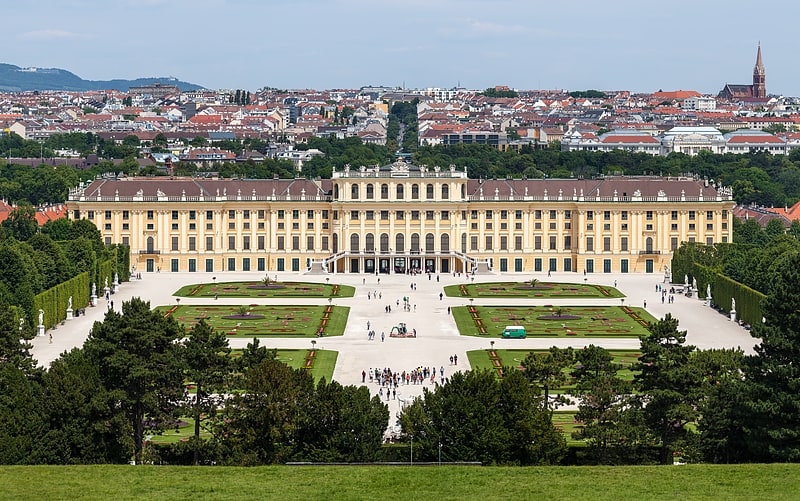
Also known as: Schloss Schönbrunn
Baroque palace with opulent interiors. Schönbrunn Palace was the main summer residence of the Habsburg rulers, located in Hietzing, Vienna. The name Schönbrunn has its roots in an artesian well from which water was consumed by the court.
The 1,441-room Rococo palace is one of the most important architectural, cultural, and historic monuments in the country. The history of the palace and its vast gardens spans over 300 years, reflecting the changing tastes, interests, and aspirations of successive Habsburg monarchs. It has been a major tourist attraction since the mid-1950s.[1]
Address: Schönbrunner Schloßstraße 47, 1130 Wien (Hietzing)
Kunsthistorisches Museum, Vienna
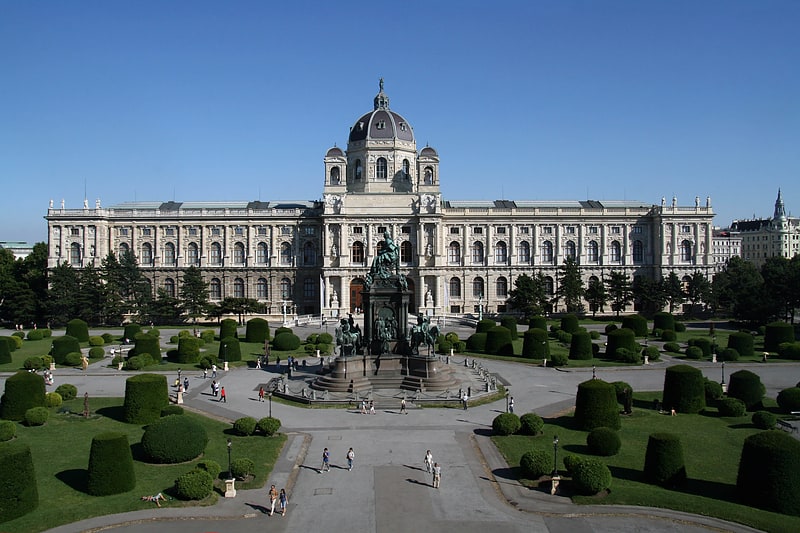
Fine arts museum in palatial building. The Kunsthistorisches Museum is an art museum in Vienna, Austria. Housed in its festive palatial building on Ringstraße, it is crowned with an octagonal dome. The term Kunsthistorisches Museum applies to both the institution and the main building. It is the largest art museum in the country and one of the most important museums worldwide.
Emperor Franz Joseph I of Austria-Hungary opened the facility around 1891 at the same time as the Natural History Museum, Vienna which has a similar design and is directly across Maria-Theresien-Platz. The two buildings were constructed between 1871 and 1891 according to plans by Gottfried Semper and Baron Karl von Hasenauer. The emperor commissioned the two Ringstraße museums to create a suitable home for the Habsburgs' formidable art collection and to make it accessible to the general public. The buildings are rectangular in shape, with symmetrical Renaissance Revival façades of sandstone lined with large arched windows on the main levels and topped with an octagonal dome 60 metres (200 ft) high. The interiors of the museums are lavishly decorated with marble, stucco ornamentation, gold-leaf, and murals. The grand stairway features paintings by Gustav Klimt, Ernst Klimt, Franz Matsch, Hans Makart and Mihály Munkácsy.[2]
Address: 5 Burgring, 1010, Wien, Vienna (Innere Stadt)
Belvedere, Vienna
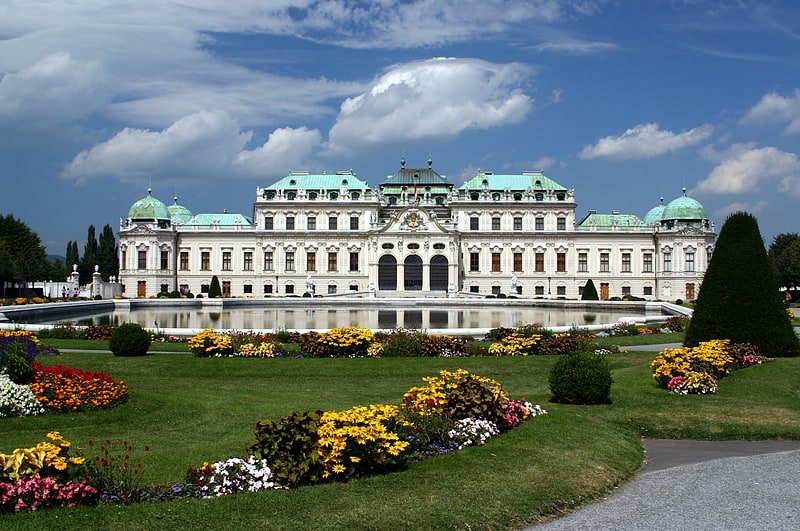
18th-century palaces with art collection. The Belvedere is a historic building complex in Vienna, Austria, consisting of two Baroque palaces, the Orangery, and the Palace Stables. The buildings are set in a Baroque park landscape in the third district of the city, on the south-eastern edge of its centre. It houses the Belvedere museum. The grounds are set on a gentle gradient and include decorative tiered fountains and cascades, Baroque sculptures, and majestic wrought iron gates. The Baroque palace complex was built as a summer residence for Prince Eugene of Savoy.
The Belvedere was built during a period of extensive construction in Vienna, which at the time was both the imperial capital and home to the ruling Habsburg dynasty. This period of prosperity followed on from the commander-in-chief Prince Eugene of Savoy's successful conclusion of a series of wars against the Ottoman Empire.[3]
Address: Prinz Eugen-Straße 27, 1030 Wien (Landstraße)
Hohensalzburg Castle, Salzburg
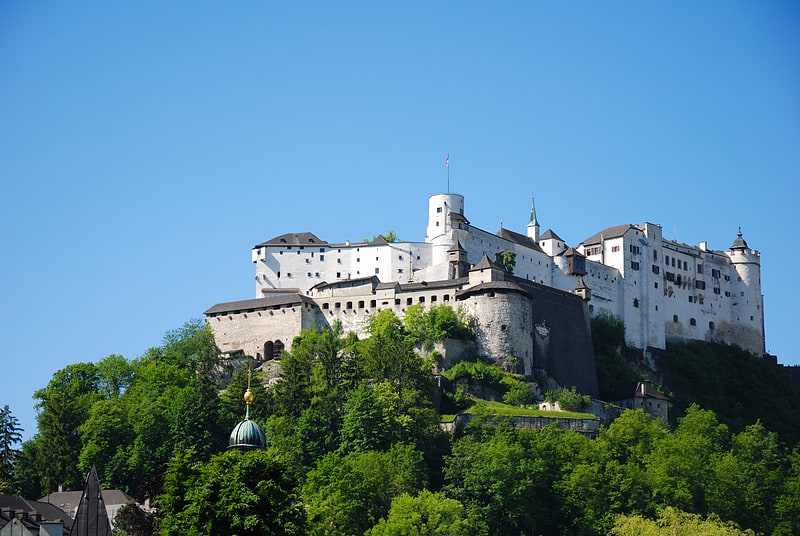
Also known as: Festung Hohensalzburg
11th-century fortress on a city hilltop. Hohensalzburg Fortress is a large medieval fortress in the city of Salzburg, Austria. It sits atop the Festungsberg at an altitude of 506 m. It was erected at the behest of the Prince-Archbishops of Salzburg. The fortress is 250 m long and 150 m wide making it one of the largest medieval castles in Europe.[4]
Address: Mönchsberg 34, 5020 Salzburg
Mirabell Palace, Salzburg
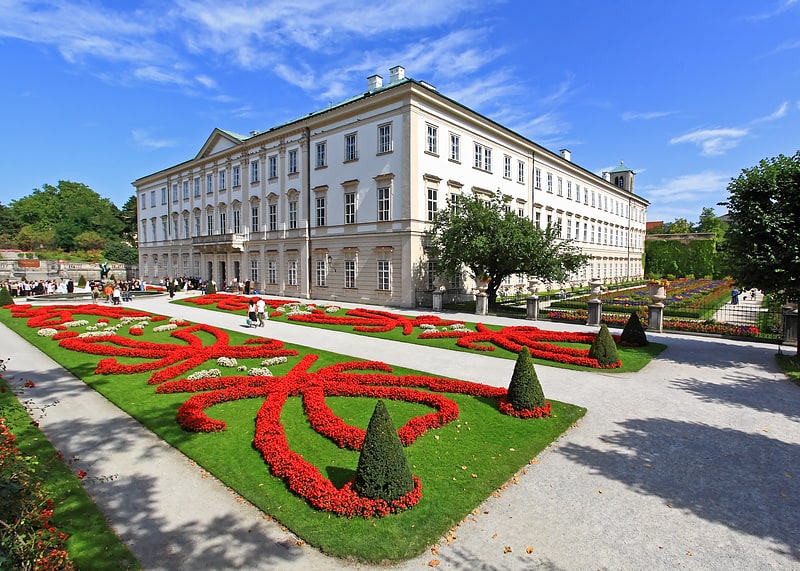
Also known as: Schloss Mirabell
Opulent 17th-century palace and gardens. Mirabell Palace is a historic building in the city of Salzburg, Austria. The palace with its gardens is a listed cultural heritage monument and part of the Historic Centre of the City of Salzburg UNESCO World Heritage Site.[5]
Address: Mirabellplatz 4, 5020 Salzburg
Eggenberg Castle, Graz

Also known as: Schloss Eggenberg
Palace with grand baroque and rococo rooms. Eggenberg Palace in Graz, is the most significant Baroque palace complex in the Austrian province of Styria. With its preserved accouterments, the extensive scenic gardens, as well as some special collections from the Universalmuseum Joanneum housed in the palace and surrounding park, Schloss Eggenberg ranks among the most valuable cultural treasures of Austria. Eggenberg Palace is situated at an elevation of 381 meters on the Western edge of the city. Its architectural design and the still visible imprint of centuries of history continue to bear witness to the vicissitude and patronage of the one-time mightiest dynasty in Styria, the House of Eggenberg.
In 2010, the significance of Schloss Eggenberg was recognised with an expansion to the listing of the Graz Historic Old Town among the UNESCO World Cultural Heritage Sites.
Surrounded by walls, with a huge portal facing West, the palace is located in the Eggenberg district of Graz and can be reached by tram. The northern corner of the palace grounds features the Planetary Garden and Lapidarium of Roman stonework as well as the entrance to the new Archeology Museum, which houses the Cult Wagon of Strettweg. At ground level, the palace houses a numismatic collection (Coin Cabinet) located in the former rooms of Balthasar Eggenberger, owner of the imperial minting license and operations in the Late Middle Ages. On the upper level, the Alte Galerie encompasses a large array of paintings, sculptures, and other works of art from the medieval era through the early modern period, spanning five centuries of European art history.[6]
Address: Eggenberger Allee 90, 8020 Graz
Schloss Ambras, Innsbruck
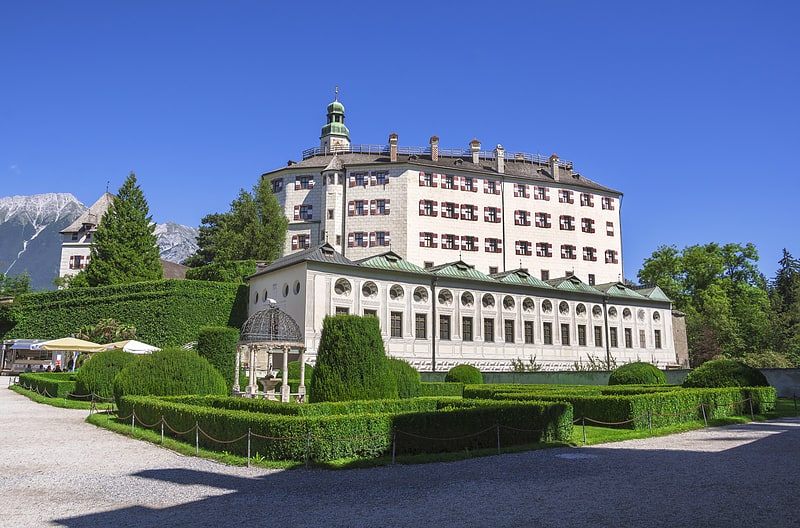
16th century castle, art and armour museum. Ambras Castle is a Renaissance castle and palace located in the hills above Innsbruck, Austria. Ambras Castle is 632 metres above sea level. Considered one of the most popular tourist attractions of the Tyrol, Ambras Castle was built in the 16th century on the spot of an earlier 10th-century castle, which became the seat of power for the Counts of Andechs. The cultural and historical importance of the castle is closely connected with Archduke Ferdinand II and served as his family's residence from 1567 to 1595. Ferdinand was one of history's most prominent collectors of art. The princely sovereign of Tyrol, son of Emperor Ferdinand I, ordered that the medieval fortress at Ambras be turned into a Renaissance castle as a gift for his wife Philippine Welser. The cultured humanist from the House of Habsburg accommodated his world-famous collections in a museum: the collections, still in the Lower Castle built specifically for that museum's purpose, make Castle Ambras Innsbruck one of the oldest museums in the world.
The Lower Castle contains armouries that feature masterpieces of the European armourers' art from the time of Emperor Maximilian I to Emperor Leopold I. As the only Renaissance Kunstkammer of its kind to have been preserved at its original location, the "Kunst- und Wunderkammer" (Chamber of Art and Wonders) represents an unrivalled cultural monument.
Above the Lower Castle is the famous Spanish Hall (Spanischer Saal), a notable example of German Renaissance architecture, which contains an intricate wood-inlay ceiling and walls adorned with 27 full-length portraits of the rulers of Tyrol. The Upper Castle contains the extensive Habsburg Portrait gallery (Habsburger Porträtgalerie) featuring paintings of numerous members of the House of Austria and other leading ruling European dynasties, including, as a remarkable feature, many portraits of princely children.[7]
Address: Schloßstraße 20, 6020 Innsbruck
Salzburg Museum, Salzburg
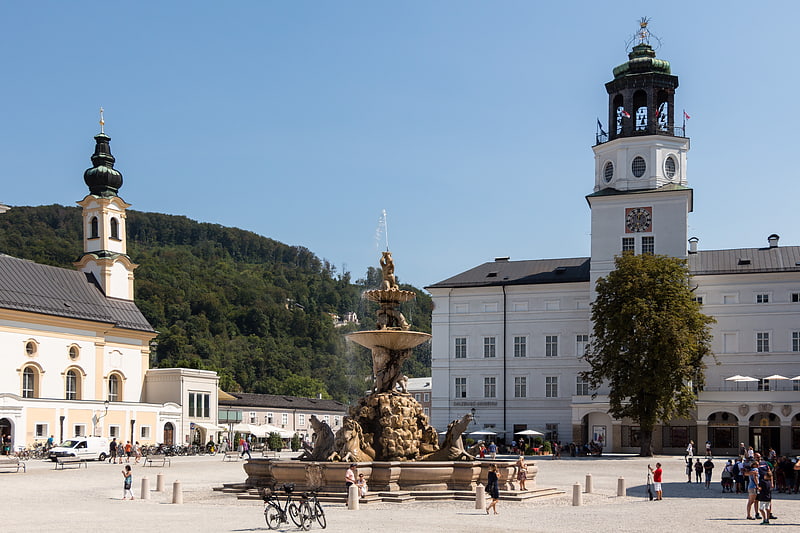
Museum in Salzburg, Austria. Housed in the Neue Residenz, the Salzburg Museum is the museum of artistic and cultural history of the city and region of Salzburg, Austria. It originated as the Provincialmuseum and was also previously known as the Museum Carolino-Augusteum.[8]
Address: Mozartpl. 1, 5020 Salzburg
Hofburg, Innsbruck
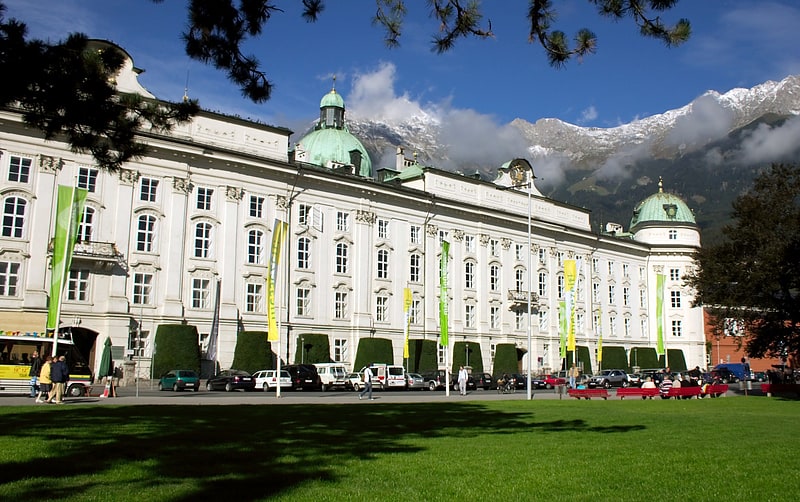
Museum in Innsbruck, Austria. The Hofburg is a former Habsburg palace in Innsbruck, Austria, and considered one of the three most significant cultural buildings in the country, along with the Hofburg Palace and Schönbrunn Palace in Vienna. The Hofburg is the main building of a large residential complex once used by the Habsburgs that still includes the Noblewomen's Collegiate Foundation, the Silver Chapel, the Hofkirche containing Emperor Maximilian's cenotaph and the Schwarzen Mandern, the Theological University, the Tyrolean Folk Art Museum, Innsbruck Cathedral, the Congress, and the Hofgarten.
The original Hofburg palace was constructed from several elements under Archduke Sigismund around 1460. This structure included sections of medieval fortifications that ran along the eastern city wall. The building incorporated the Rumer Gate, which was later converted into the Heraldic Tower in 1499 by Jörg Kölderer under Emperor Maximilian I. The palace was expanded several times during the next 250 years. Between 1754 and 1773, the Hofburg palace underwent two stages of Baroque structural changes under Empress Maria Theresia: the south tract was constructed (1754–1756) on the Hofgasse according to plans by J. M. Gumpp the Younger, and the main façade was added (1766–1773) on the Rennweg according to plans by C. J. Walter. During this period, the Giants' Hall was completed with ceiling frescoes by F. A. Maulbertsch, and the Imperial Chapel was built (1765) in the room where Maria Theresa's husband Emperor Francis I had died.
Today, the Hofburg contains five themed museum areas: Maria Theresa's Rooms from the eighteenth century, Empress Elisabeth's Apartment from the nineteenth century, a Furniture Museum, an Ancestral Gallery, and a Painting Gallery. These themed museum areas illustrate various aspects of the political and cultural history of the former imperial palace, which remained in the possession of the Habsburgs for more than 450 years.[9]
Address: Rennweg 1/3, 6020 Innsbruck
Chamber of Art and Curiosities, Innsbruck
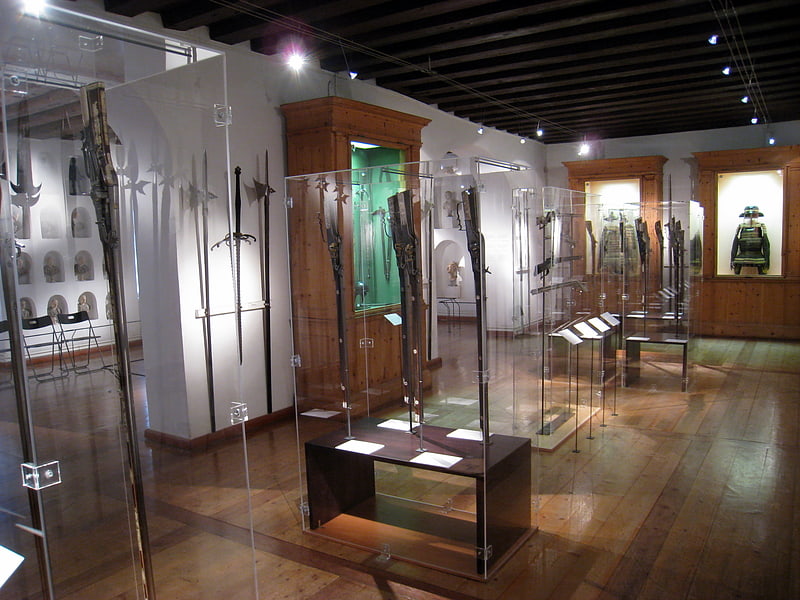
The Chamber of Art and Wonders is a cabinet of rarities - often, but misleadingly labelled cabinet of curiosities - created by Ferdinand II, Archduke of Austria, sovereign ruler of the County of Tyrol and Further Austria, in the 16th century. Ferdinand II, son of Emperor Ferdinand I, was one of history's most prominent collectors of art. The cultured humanist from the House of Austria accommodated his world-famous collections in a museum built specifically for that purpose. So, the Lower Castle as building itself became an exhibit, making Ambras Castle in Innsbruck perhaps the oldest museum in the world. As the only Renaissance Kunstkammer of its kind to have been preserved at its original location, the Chamber of Art and Wonders represents an unrivalled cultural monument.
Representing an outstanding example of a late Renaissance encyclopedic collection of its genre, it continues to be displayed at Ambras Castle Innsbruck, the same setting since its inception. Ferdinand II, like many other rulers of the Renaissance, was interested in promoting the arts and sciences. The Habsburg Archduke spent considerable time and money on his unique collection: armour, weapons, portraits, natural objects, rarities, 'wonders of nature', most recent scientific instruments, musical instruments, precious items, and so on; which in later times should be classified as artificialia, naturalia, scientifica, exotica, and mirabilia.
Beside the "Chamber of Art and Wonders" Ambras Castle is home to a famous collection of armouries and early modern weapons feature masterpieces of the European armourer's art from the Renaissance; Archduke Ferdinand II was the first in the history of the museum to present his collection according to a systematic concept within a specially constructed museum building. The "Glassammlung Strasser" (Strasser Collection of Glass) boasts precious glassware from the Renaissance and Baroque periods. The "Habsburger Porträtgalerie" (Habsburg Portrait Gallery) laid out on three floors is open to visitors in summer. The paintings include works by famous painters such as Hans Burgkmair, Lucas Cranach the Younger, Giuseppe Arcimboldo, Peter Paul Rubens, Diego Velázquez, and others. Today, these collections at Ambras are administered by the KHM-Museumsverband, as part of the Kunsthistorisches Museum, Vienna.[10]
Liechtensteinklamm, St. Johann im Pongau
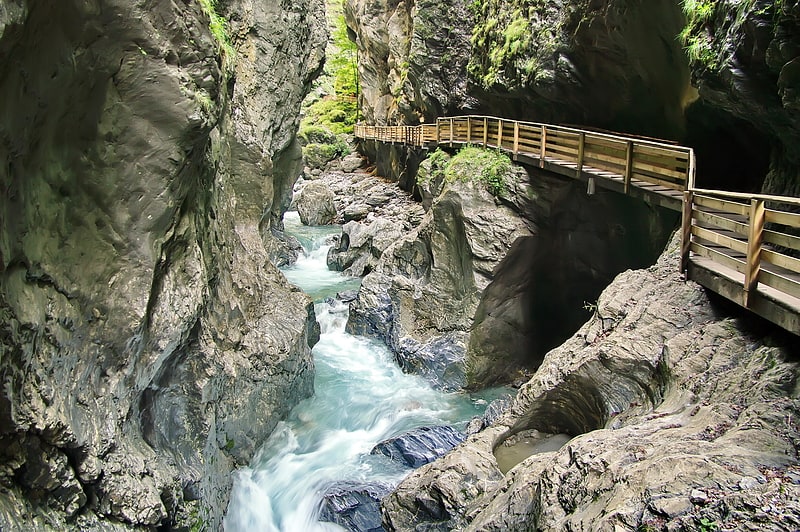
Tourist attraction in St Johann im Pongau, Austria. Liechtensteinklamm is a particularly narrow gorge with walls up to 300m high, located in the Austrian Alps 50 km south of Salzburg. It is around 4 km long and named after Johann II of Liechtenstein who had the walkways installed in 1875.
The gorge is around 4 km in length of which 1 km is accessible to visitors by means of wooden walkways (closed in winter months). It has a depth of up to 300m and in some places is only a few meters wide. At the end of the gorge is a waterfall. It receives around 100,000 visitors a year.
The waters of the Großarler Ache, a mountain stream, formed the gorge over thousands of years. In 1875 work began by members of the Pongau Alpine Club to make the gorge accessible, however was unfinished due to a lack of funds. Prince Johann II. of Liechtenstein, who ran a hunting lodge in the nearby Großarl, donated 600 guilders for an expansion of the work. At the completion of work in 1876 the gorge was renamed to honour the generous donation from the Prince.
According to legend, the gorge was created when the devil full of anger and rage over a failed plan, flew across the canyon throwing water into it with such force as to carve the rock.[11]
Kunsthaus, Graz
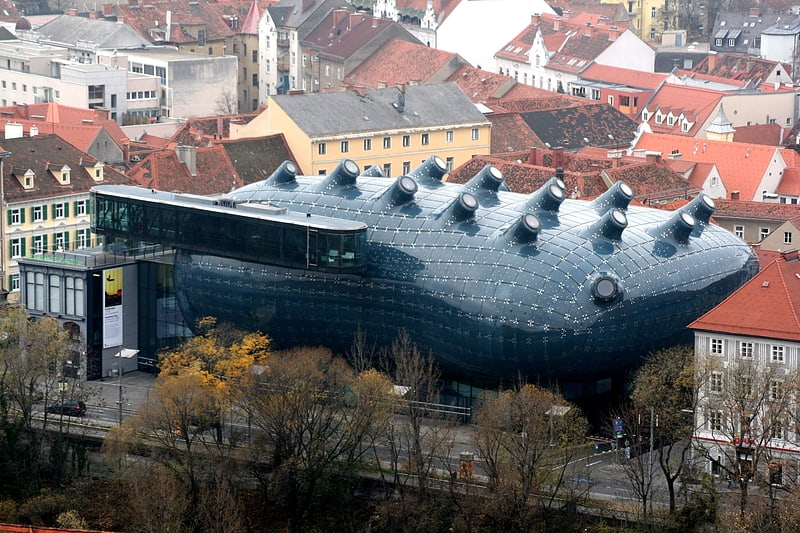
Amorphous blue contemporary art museum. The Kunsthaus Graz, Grazer Kunsthaus, or Graz Art Museum was built as part of the European Capital of Culture celebrations in 2003 and has since become an architectural landmark in Graz, Austria. Its exhibition program specializes in contemporary art from the 1960s onwards.[12]
Address: Lendkai 1, 8020 Graz
Minimundus, Klagenfurt
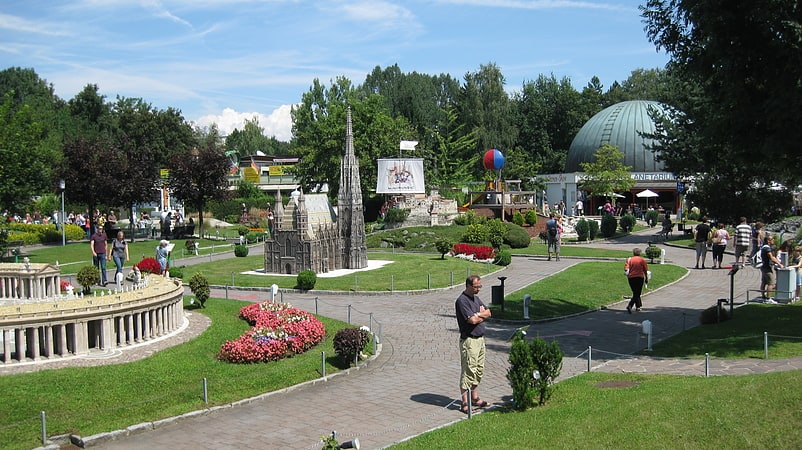
Miniature models of famous landmarks. Minimundus is a miniature park in Klagenfurt in Carinthia, Austria. It displays over 150 miniature models of architecture from around the world, built at a ratio of 1:25.[13]
Address: Villacher Str. 241, 9020 Klagenfurt am Wörthersee
Synagoge, Graz

The New Synagogue of Graz, is a Jewish synagogue in the city of Graz, Austria. Within the city, it is located on David-Herzog-Place, on the right bank of the Mur River in the Gries neighborhood of Graz. The synagogue serves the Jews of Graz, Styria, Carinthia, and southern parts of Burgenland.[14]
Address: David Herzogplatz 1, 8020 Graz
Hallstatt Museum, Hallstatt
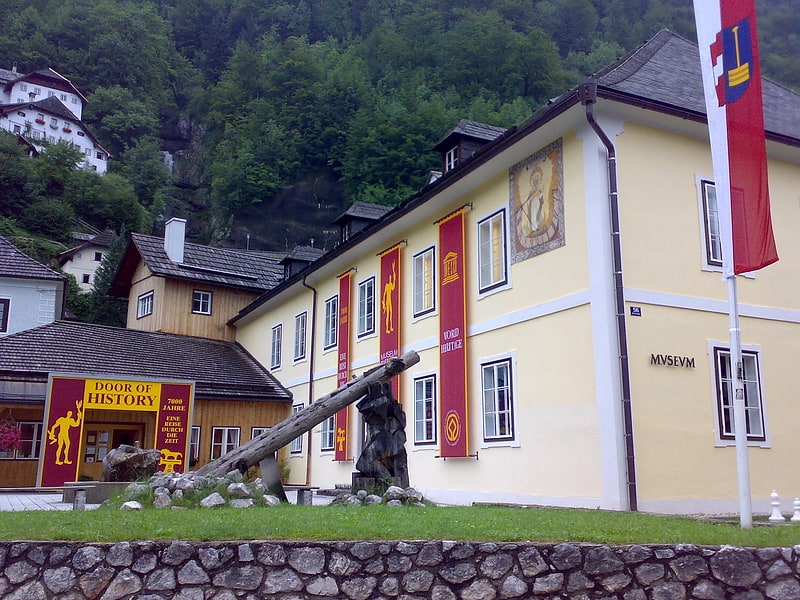
Also known as: Museum Hallstatt
Museum. The Hallstatt Museum is a museum in Hallstatt, Upper Austria, that has an unrivalled collection of discoveries from the local salt mines and from the cemeteries of Iron Age date near to the mines, which have made Hallstatt the type site for the important Hallstatt culture. The museum is close to the Hallstättersee, below the salt mines on the mountainside. The museum, the salt mines, and the Dachstein Ice Cave are designated as an UNESCO World Heritage Site.
Since 2002 the museum has occupied the former Hallstatt parsonage, and the previous holdings of the museum have been reunited with many of the objects which had previously been on display at the Naturhistorisches Museum in Vienna.[15]
Address: Seestraße 56, 4830 Hallstatt
Ursuline Church of St. Michael, Linz
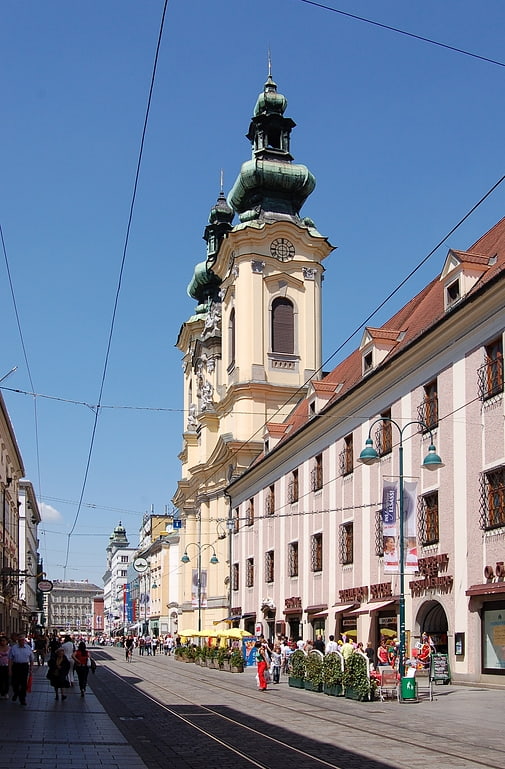
Catholic church in Linz, Austria. The Ursuline Church in Linz, Austria, dedicated to Archangel Michael, was built between 1736 and 1772 for the local Ursulines. It has two towers and a late baroque facade. The design was done by the architect Johann Haslinger. The church was dedicated in 1757.
It is connected to the former Ursuline convent, today a cultural center.[16]
Address: 29 Landstraße, Linz (Innenstadt)
New Cathedral, Linz
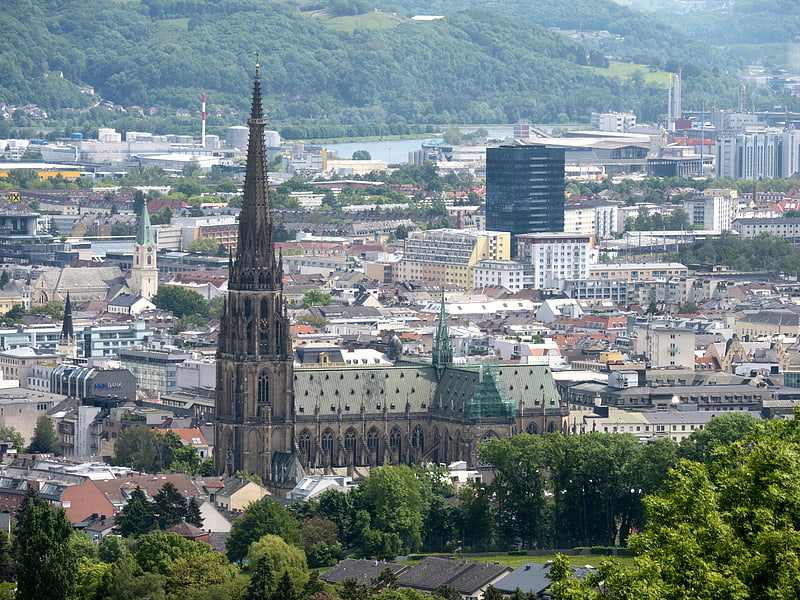
Also known as: Mariä-Empfängnis-Dom
Catholic cathedral with 135m tower. The New Cathedral, also known as the Cathedral of the Immaculate Conception, is a Roman Catholic cathedral located in Linz, Austria. The neo-Gothic church is the largest, though not the tallest church in Austria.[17]
Address: Herrenstraße 26, 4020 Linz (Innenstadt)
Ars Electronica Center, Linz
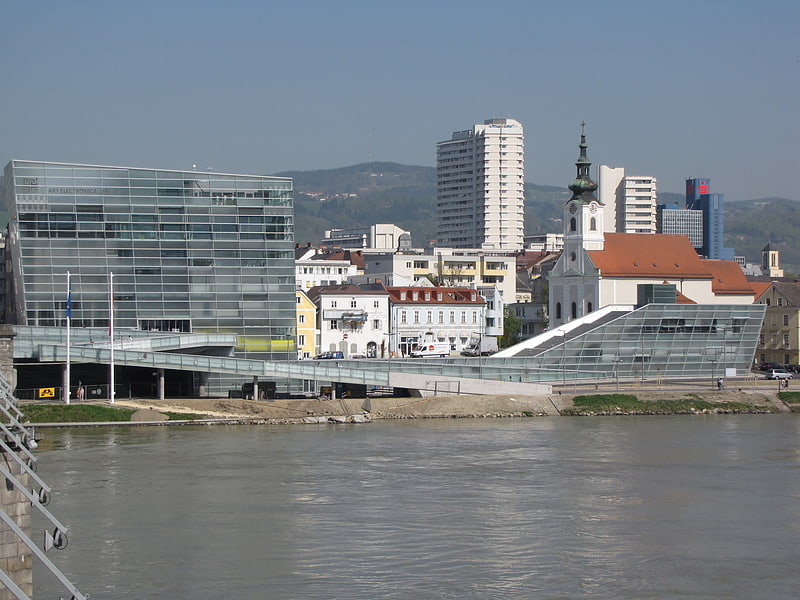
Ultramodern venue for electronic arts. Ars Electronica Linz GmbH is an Austrian cultural, educational and scientific institute active in the field of new media art, founded in Linz in 1979. It is based at the Ars Electronica Center, which houses the Museum of the Future, in the city of Linz. Ars Electronica's activities focus on the interlinkages between art, technology and society. It runs an annual festival, and manages a multidisciplinary media arts R&D facility known as the Futurelab. It also confers the Prix Ars Electronica awards.[18]
Address: Ars-Electronica-Strasse 1, 4040 Linz (Urfahr)
Schloss Esterházy, Eisenstadt
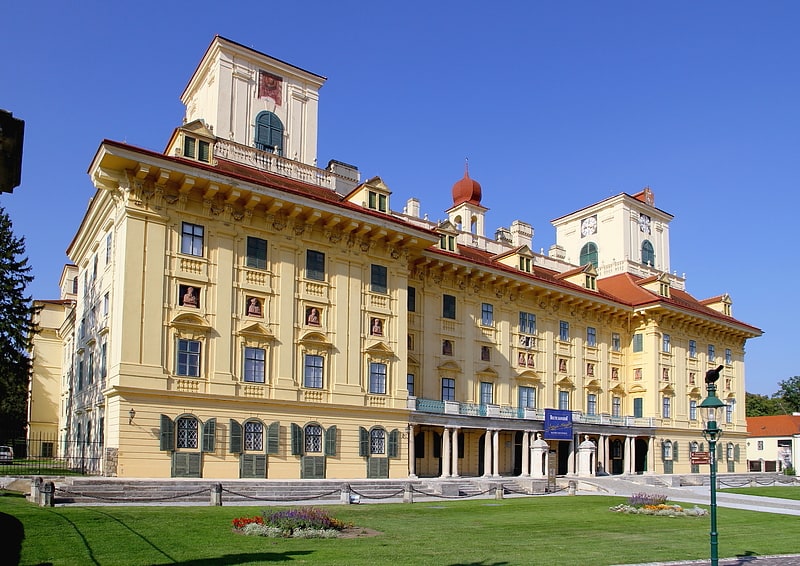
Baroque palace and cultural event venue. Schloss Esterházy is a palace in Eisenstadt, Austria, the capital of the Burgenland state. It was constructed in the late 13th century, and came under ownership of the Hungarian Esterházy family in 1622. Under Paul I, 1st Prince Esterházy of Galántha the estate was converted into a baroque castle which remained the principal residence and center of administration of the family for over 300 years.[19]
Address: Esterhazyplatz 1, 7000 Eisenstadt
Gustav Mahler Komponierhäuschen, Klagenfurt

The composing hut of Gustav Mahler, German: Gustav Mahler-Komponierhäuschen, is a little museum and memorial in Maiernigg, near Maria Wörth in Carinthia, Austria. It is dedicated to the classical composer Gustav Mahler. In this hut he retreated from 1900 to 1907 in order to compose music. Since 7 July 1986 a permanent exhibition can be seen here.
There is also a composing hut at the Attersee, Upper Austria, and one next to the Gustav Mahler Stube in South Tyrol, Italy.[20]
Stift Klosterneuburg, Klosterneuburg
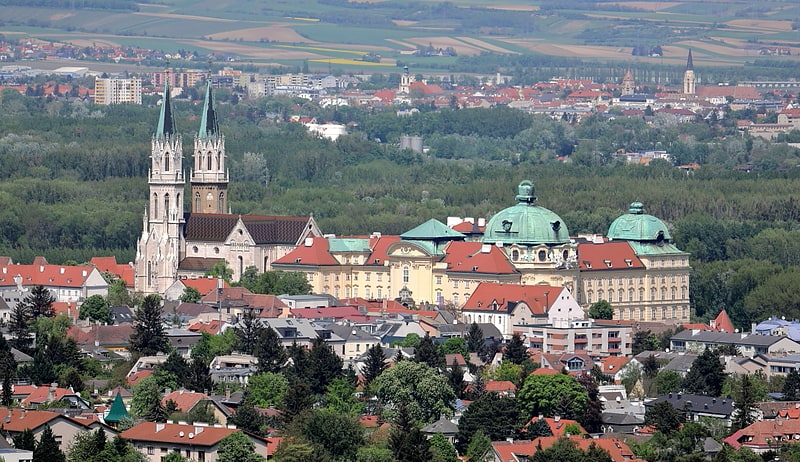
Large hilltop monastery and famous altar. Klosterneuburg Abbey or Monastery is a twelfth-century Augustinian monastery of the Roman Catholic Church located in the town of Klosterneuburg in Lower Austria. Overlooking the Danube, just north of the Vienna city limits at the Leopoldsberg, the monastery was founded in 1114 by Saint Leopold III of Babenberg, the patron saint of Austria, and his second wife Agnes of Germany.
The abbey church, dedicated the Nativity of Mary (Maria Geburt), was consecrated in 1136 and remodeled in the Baroque style in the seventeenth century. The impressive monastery complex was mostly constructed between 1730 and 1834. Its foundations, including a castle tower and a Gothic chapel, date back to the twelfth century. Other older buildings still extant within the complex include the chapel of 1318 with Saint Leopold's tomb. From 1634 on, the Habsburg rulers had the facilities rebuilt in the Baroque style, continued by the architects Jakob Prandtauer and Donato Felice d'Allio. The plans to embellish the monastery on the scale of an Austrian Escorial were later resumed by the Neoclassical architect Joseph Kornhäusel, though only small parts were actually carried out. In 1879, the abbey church and monastery were restored according to plans by Friedrich von Schmidt, and the neo-Gothic twin steeples were erected.
Klosterneuburg Monastery contains the Verduner Altar, made in 1181 by Nicholas of Verdun. Its three parts comprise 45 gilded copper plates modeled on Byzantine paragons, similar to the Shrine of the Three Kings at Cologne Cathedral. The monastery also contains a museum with a collection of Gothic and Baroque sculpture and a gallery of paintings, including fifteen panel paintings by Rueland Frueauf from 1505, four Passion paintings from the backside of the Verduner Altar from 1331, and the Babenberg genealogical tree.[21]
Address: Stiftsplatz 1, 3400 Korneuburg
Simony Hut, Hallstatt
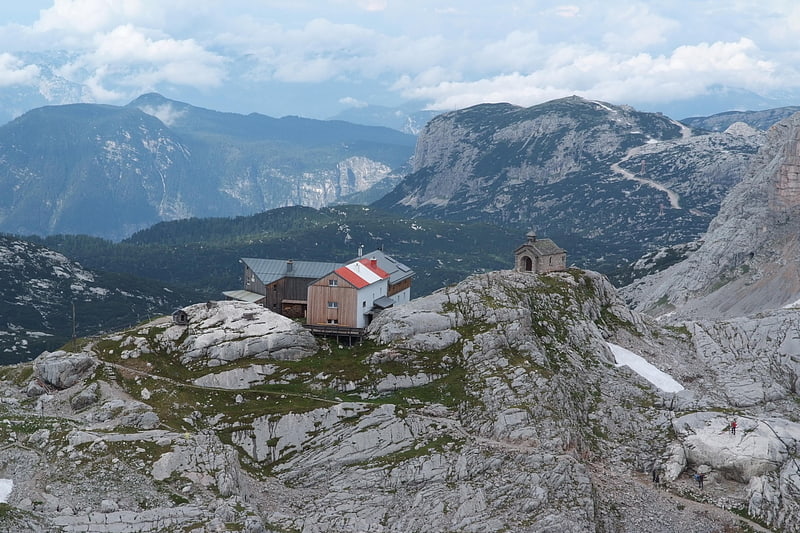
Also known as: Simonyhütte
Mountain cabin in Hallstatt, Austria. The Simony Hut is an Alpine club hut belonging to the Austrian Alpine Club located at a height of 2,205 metres, just below the Hallstätter Glacier at the foot of the Hoher Dachstein in Austria. The hut, which is named after Friedrich Simony the first person to ascend Hoher Dachstein, is high above Hallstatt in Upper Austria in the northern part of the Dachstein Mountains. It is open year-round and, in winter, offers numerous options for ski tours and snowshoe walking.
The Simony Hut is an important base for climbers because they are able to set out from here on long tours over the Dachsteins. There is also a mountaineering school where training courses are run for glacier or ice climbing. The Dachstein Chapel is nearby.[22]
Festung Kufstein, Kufstein
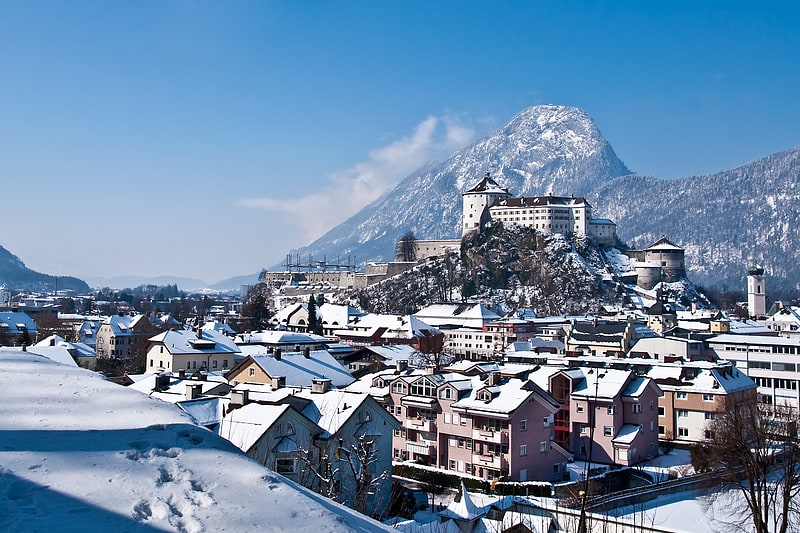
Castle in Kufstein, Austria. The Kufstein Fortress is the main landmark of Kufstein, a town in Tyrol, Austria. It is sometimes wrongly referred to as Geroldseck Fortress. It is on a hill commanding Kufstein proper. Kufstein Fortress is 507 metres above sea level.
The fortress is linked to the city below by the Festungsbahn, a funicular railway.[23]
Address: Festung 2, 6330 Kufstein
Stift Viktring, Klagenfurt
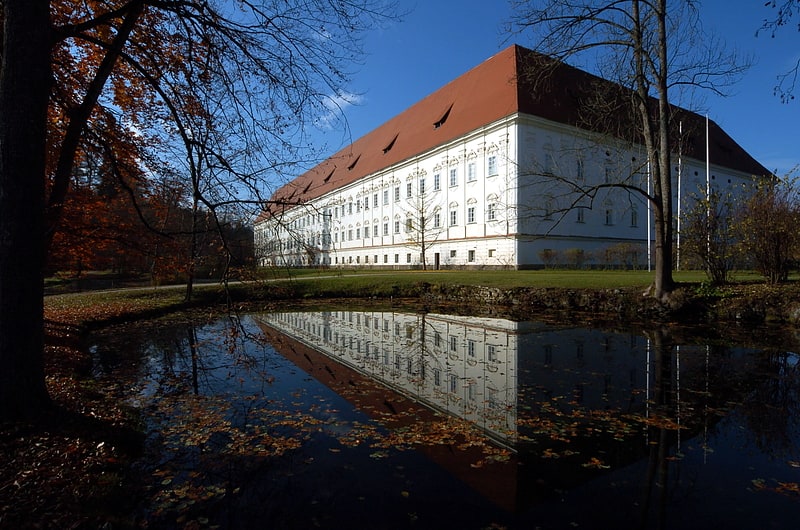
Monastery in Klagenfurt, Austria. Viktring Abbey is a former Cistercian monastery in the Austrian state of Carinthia. Stift Viktring is now the name of the Roman Catholic parish in Viktring, since 1973 a district of the Carinthian capital Klagenfurt.[24]
Address: Stift-Viktring-Strasse 25, 9073 Klagenfurt
Kunsthaus Bregenz, Bregenz

Museum of contemporary art, with a café. The Kunsthaus Bregenz presents temporary exhibitions of international contemporary art in Bregenz, capital of the Austrian Federal State of Vorarlberg. Commissioned by the State of Vorarlberg and designed by the Swiss architect Peter Zumthor, it was built between 1990 and 1997.[25]
Address: Karl-Tizian-Platz 1, 6900 Bregenz
Kitzsteinhorn, Zell am See

Alpine mountain with glacier skiing. The Kitzsteinhorn is a mountain in the High Tauern range of the Central Eastern Alps in Austria. It is part of the Glockner Group and reaches a height of 3,203 m AA. The Kitzsteinhorn Glaciers are a popular ski area.[26]
Address: Kesselfallstrasse 60, 5710 Kaprun
Kitzbüheler Horn, Kitzbühel
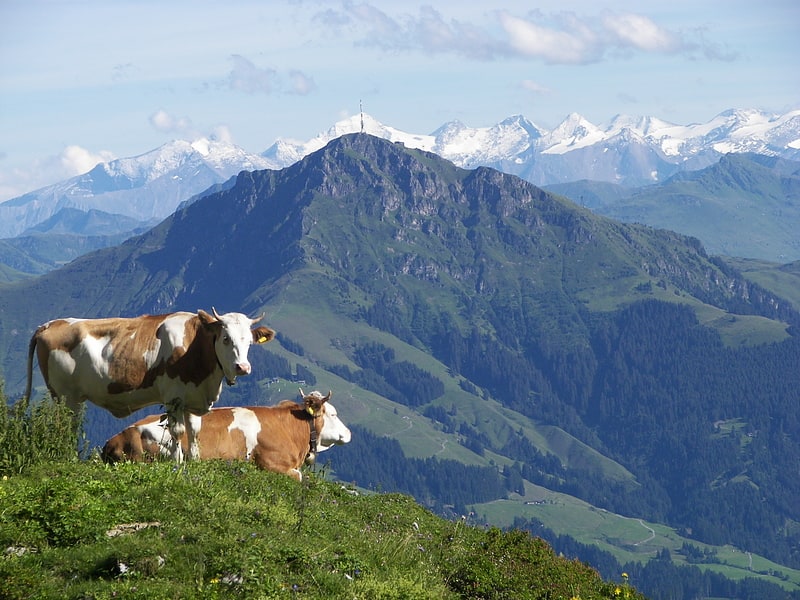
Mountain with cable cars, skiing . The Kitzbüheler Horn is a mountain in the Kitzbühel Alps in Tyrol, Austria, whose western flank lies near the smart ski resort of Kitzbühel. With a height of 1,996 m it only just misses being a 'two-thousander'.
At the summit is a 102 metre high TV tower belonging to the ORF and known as the Kitzbüheler Horn Transmission Tower (Sendeturm Kitzbüheler Horn). The Harschbichl (1,604 m) is a sub-peak to the north which is also accessible.[27]
Address: Kitzbüheler Horn, 6370 Kitzbühel
Landskron Castle, Villach

Also known as: Burg Landskron
Castle in Villach. Landskron Castle is a medieval hill castle northeast of Villach in the state of Carinthia, Austria. Dating to the early 14th century, the castle ruins are located on a rock cone of the Ossiach Tauern range, at an elevation of 658 metres above sea level. Today Landskron Castle, its falconry centre conducting regular flying demonstrations, and the nearby macaque enclosure are major tourist destinations.[28]
Address: Schlossbergweg 30, 9523 Landskron
Vorarlberg museum, Bregenz

Museum. The vorarlberg museum in Bregenz is the state art and cultural museum of the Austrian federal state of Vorarlberg.
It was founded in 1857, and has since been a centre for collection and preservation of the state's art and cultural material. The museum conducts research into this material and makes it available to the public. In terms of content, the museum's work focuses on Vorarlberg material, and at the same time considers this in a context which goes beyond the state's boundaries. The collection contains 150,000 artifacts from archaeology, history, history of art and folklore.
The museum co-operates with other national, international and regional cultural institutions and aims at supporting science by cooperating with research facilities and making research findings visible.[29]
Address: Kornmarktpl. 1, 6900 Bregenz
Lake Zell, Zell am See

Also known as: Zeller See
Alpine lake with year-round recreation. Lake Zell is a small freshwater lake in the Austrian Alps. It takes its name from the city of Zell am See, which is located on a small delta protruding into the lake. The lake is 4 kilometres long and 1.5 kilometres wide. It is up to 73 metres deep and at an elevation of 750 metres above sea level.
The lake is fed by numerous small mountain streams in summer, but only one stream flows out of it into the Salzach. In winter the lake completely freezes and is used for winter sports. In summer the lake is used for pleasure boating (boats powered by combustion engines are not allowed except for the ferries that cross the width of the lake from Zell to Thumersbach, so electrically powered boats can be rented instead). The water is very clear and suitable for swimming or diving, but can be chilly.
The southern end of the lake, near Schüttdorf, is shallower and mostly filled with water weed, making it unsuitable for boating or swimming.[30]
Klosterkeller, Bregenz
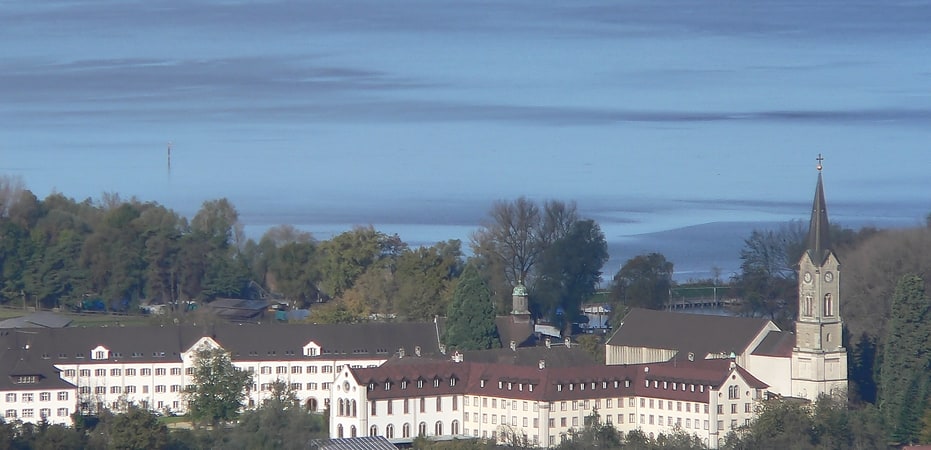
Also known as: Territorialabtei Wettingen-Mehrerau
Abbey. Wettingen-Mehrerau Abbey is a Cistercian territorial abbey and cathedral located at Mehrerau on the outskirts of Bregenz in Vorarlberg, Austria. Wettingen-Mehrerau Abbey is directly subordinate to the Holy See and thus forms no part of the Catholic Archdiocese of Salzburg. The abbot of Wettingen-Mehrerau, however, is a member of the Austrian Bishops' Conference. The official name of the abbey is Beatae Mariae Virginis de Maris Stella et de Augia Majore.[31]
Address: Mehrerauerstrasse 66, 6900 Bregenz
Schmittenhöhe, Zell am See
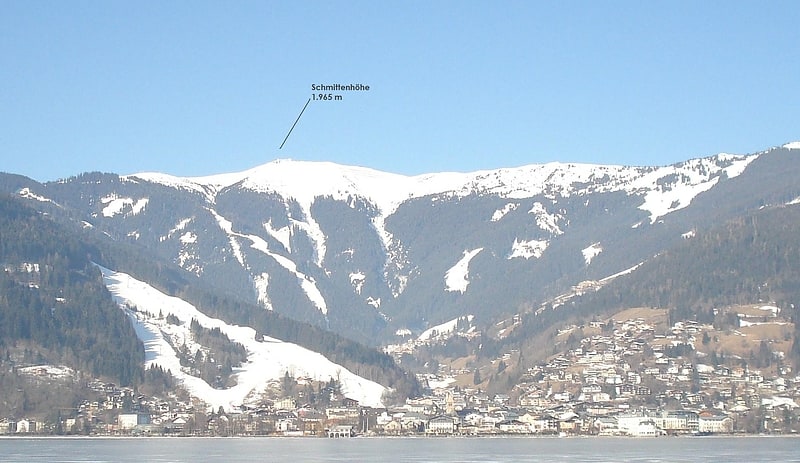
Mountain with activities and a cablecar. The Schmittenhöhe is a mountain, 1,965 m high, on the eastern edge of the Kitzbühel Alps. It is the local mountain of the district capital of Zell am See, from where a cable car was built in 1927 by Adolf Bleichert & Co. that runs to the summit. The cable car system has been renovated several times since. From the summit of the Schmittenhöhe there is a good view of over 30 three-thousanders as well as the lake of Zeller See, the river basin and the whole Saalach valley.[32]
Address: Schmittenhöhe 20, 5700 Zell am See
Keltenmuseum, Hallein
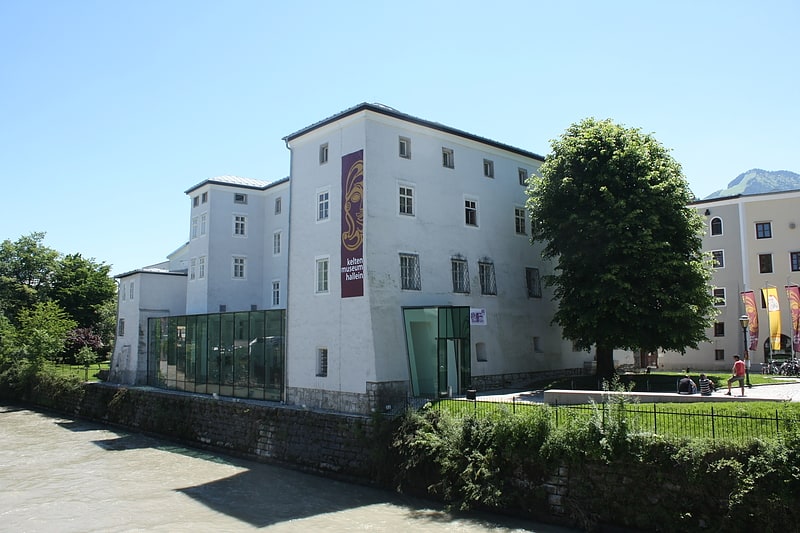
Museum in Hallein, Austria. The Keltenmuseum in Hallein near Salzburg contains major discoveries from the La Tene period of the Iron Age which come from burials in the area surrounding the nearby Hallein Salt Mine, at Dürrnberg. The Museum was founded in 1882 and was housed in the Bürgerspital. In 1930 it was moved into the Rathaus and from 1952 occupied a gateway of the town or stadt's fortifications. In 1970 the name was changed to Keltenmuseum and the museum was moved into the former Salt Offices on the Pflegerplatz, which fronts the river Salzach. In 1980 the Museum staged a major exhibition "Die Kelten in Mitteleuropa", which demonstrated the wealth of discoveries that were being made at the Hallein. In 1993-4 the Austrian architect Heinz Tesar drew up plans for the conversion and extension of the Museum and on 1 January 2012 the Museum became a constituent part of Salzburg Museum.[33]
Address: Pflegerpl. 5, 5400 Hallein
Kaiservilla, Bad Ischl

Summer residence of Habsburg emperors. The Kaiservilla in Bad Ischl, Upper Austria, was the summer residence of Emperor Franz Joseph I and Empress Elisabeth of Austria, known as Sisi. The mansion is currently the residence of their great-grandson Archduke Markus Emanuel Salvator.[34]
Address: Jainzen 38, 4820 Bad Ischl
Dobratsch, Villach
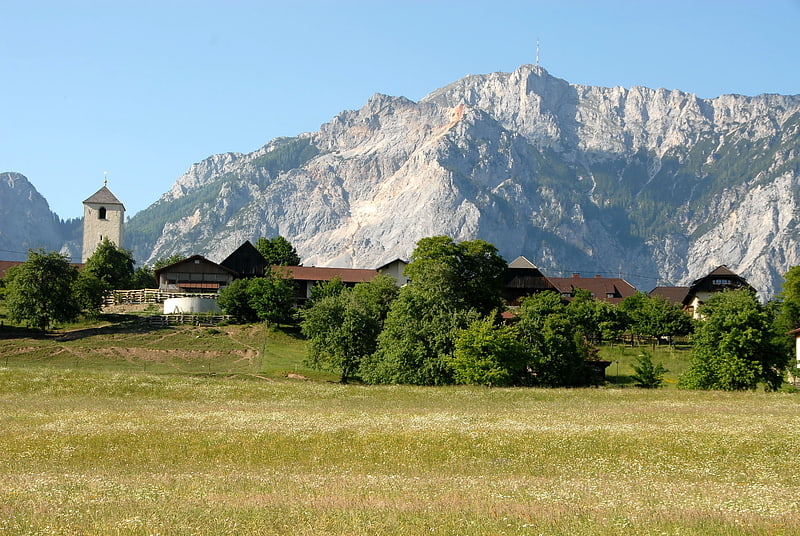
Mountain range in Austria. Dobratsch or the Villacher Alps is a mountain range in the Carinthia region of Austria. Its peak is 2,166 meters above sea level and it is a protected natural park. It forms the foothills of the Gailtal Alps and is immediately west of the town of Villach.[35]
Hahnenkamm, Kitzbühel, Kitzbühel
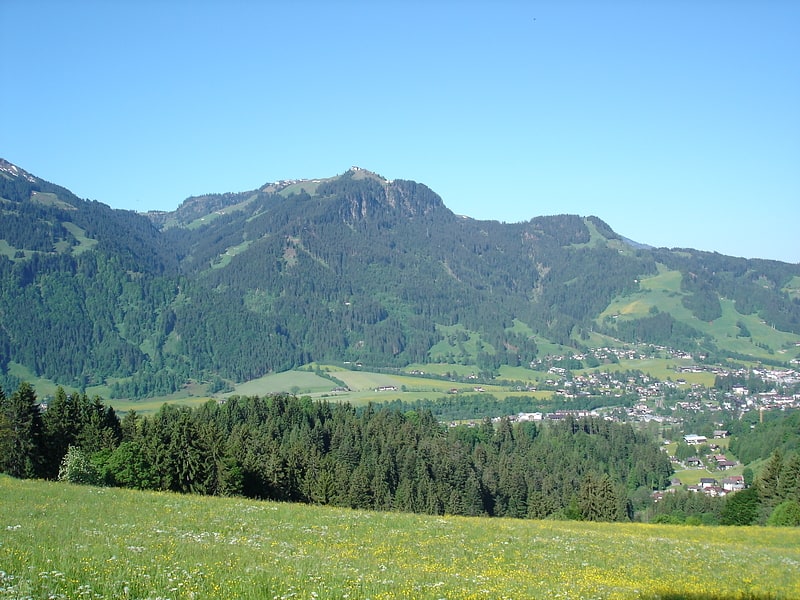
The Hahnenkamm is a mountain in Europe, directly southwest of Kitzbühel in the Kitzbühel Alps of Austria. The elevation of its summit is 1,712 metres above sea level.
The Hahnenkamm (German: rooster's comb) is part of the ski resort of Kitzbühel, and hosts an annual World Cup alpine ski race, the Hahnenkammrennen. The most famous slope on the Hahnenkamm is the classic downhill course, the Streif (streak, or stripe), which is regarded as the most demanding race course on the World Cup circuit. The course features highly technical, "fall-away" turns (reverse bank), many with limited visibility. It also contains several flat gliding sections, immediately preceded by difficult turns, placing a premium on both technical and gliding skills. The Streif is located on the mountain's northeast face which in January is mostly in the shade, adding the difficulty of flat vision to the already exceptionally demanding run.[36]
Römertherme Baden, Baden bei Wien

Watersports, Hot springs, Water park, Amusement park, Swimming
Address: Brusattipl. 4, 2500 Baden
Lake Faak, Villach

Also known as: Faaker See
Fishing spot with nearby hotels and dining. Lake Faak is a lake in the Austrian state of Carinthia. With an area of approximately 2.2 km2, it is the state's fifth-largest lake.[37]
Beethoven-Haus, Krems
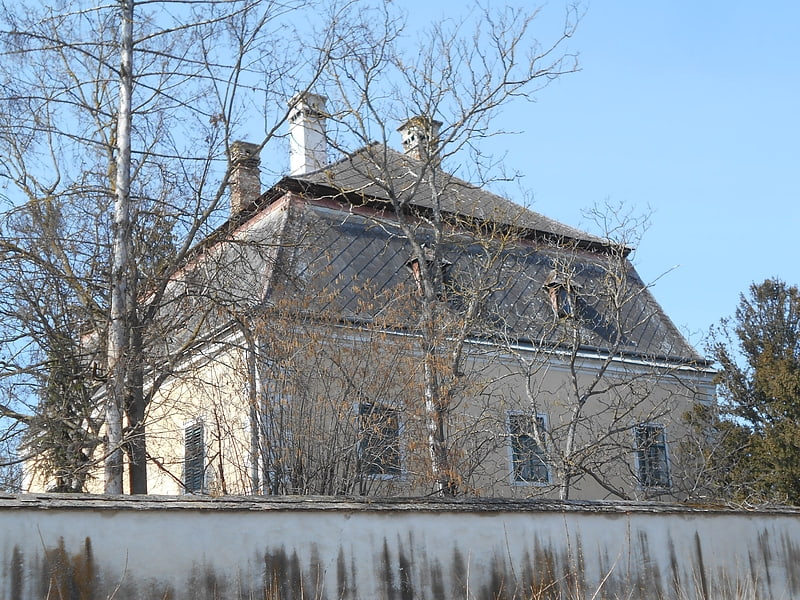
Museum in Krems an der Donau, Austria. The Beethoven House is a museum in the village of Gneixendorf near Krems an der Donau in Austria. It is a former residence of Ludwig van Beethoven and it is part of the cultural heritage of Austria.
The residence currently features several rooms furnished as a private museum The museum offers tours by appointment. The rooms where Van Beethoven resided are on the second floor. It concerns four chamber, a large hallway and an adjoined piano chamber. The rooms have been decorated with various mementos. Also there are a hearth and lamps which originate from the composer's lifetime. In the garden, there is a large rock featuring a copper portrait of Van Beethoven.
In this residence he composed the new final movement of his String Quartet No. 13 (Beethoven) (opus 130). He had initially intended the Große Fuge to be the final movement, which was later renamed opus 133.
The house was owned by his brother. Van Beethoven came here with his nephew and ward. His nephew had attempted suicide on 6 August 1826 and he had spent the weeks before their arrival in a hospital. Van Beethoven accepted his brother's invitation to stay over, and resided in the house between 25 September and 2 November 1826. The house is currently a part of the cultural heritage of Austria.[38]
Address: 19 Schloßstraße, Krems
Schwarzsee, Kitzbühel
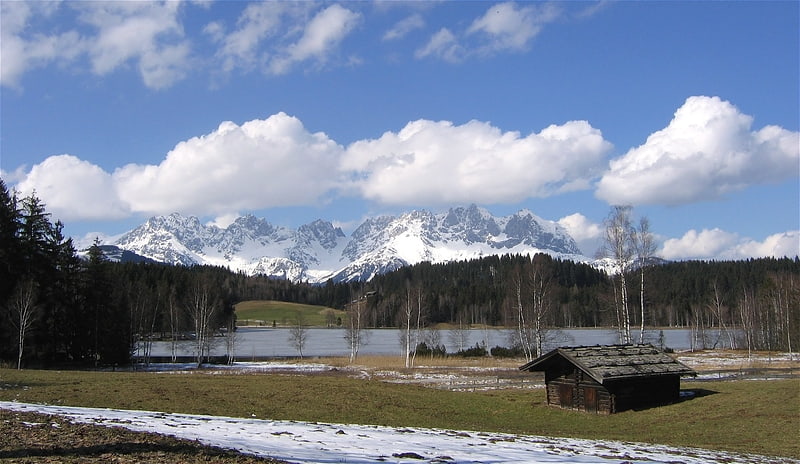
Lake in Austria. Schwarzsee is a moor lake in Tyrol, Austria.[39]
Bergkirche, Eisenstadt
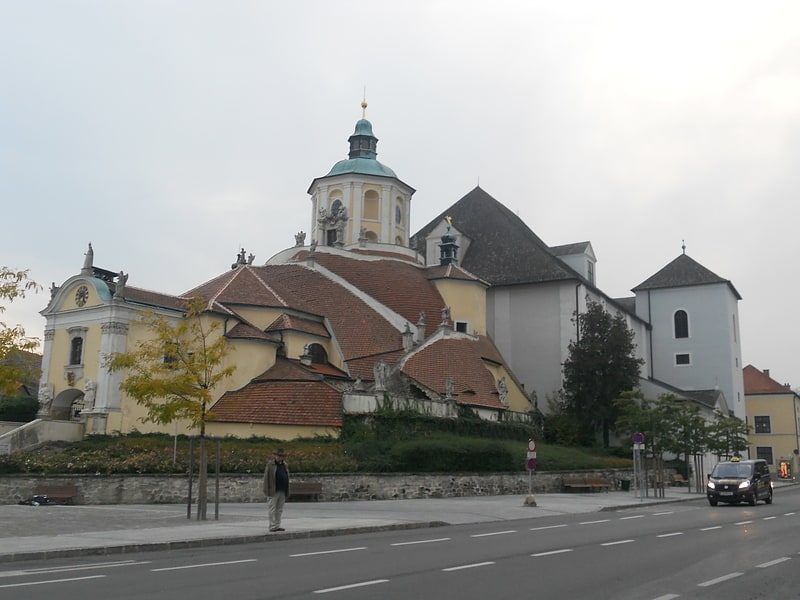
Catholic church in Eisenstadt, Austria. The Bergkirche is a church in Eisenstadt, the capital of the state of Burgenland in Austria. The church was built in the early 18th century by Prince Paul Esterházy. Eisenstadt was the seat of the Esterházy family, and the church lies just a short walk to the west of the family's main palace.[40]
Address: Josef-Haydn-Platz 1, 7062 Eisenstadt
Treppe ins Nichts, Hallstatt
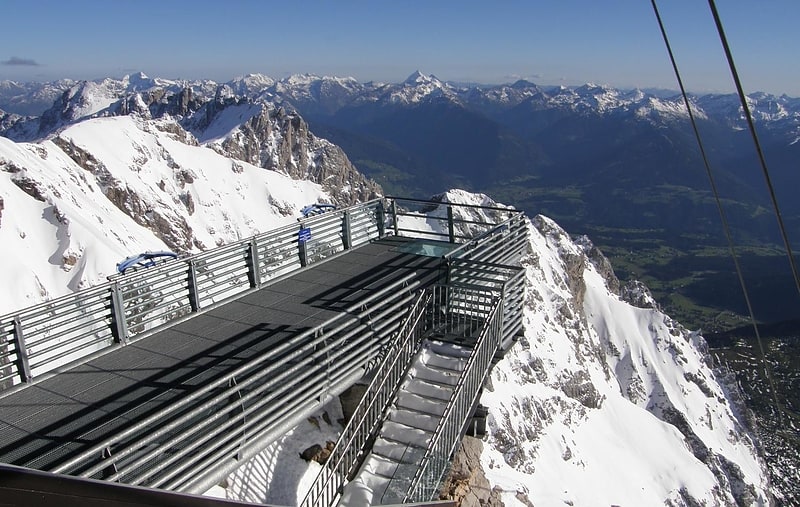
The Dachstein Skywalk is a viewing platform on the south side of the Dachstein-Südwandbahn mountain station on the Hunerkogel in the Dachstein Glacier ski area of Upper Austria.
Strandbad Klosterneuburg, Klosterneuburg
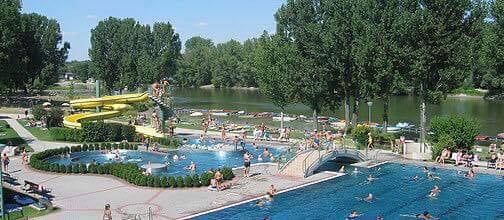
Watersports, Theme park, Beach, Water park, Swimming, Amusement park
Address: Linker Strandweg, 3400 Klosterneuburg
Schattenburg, Feldkirch
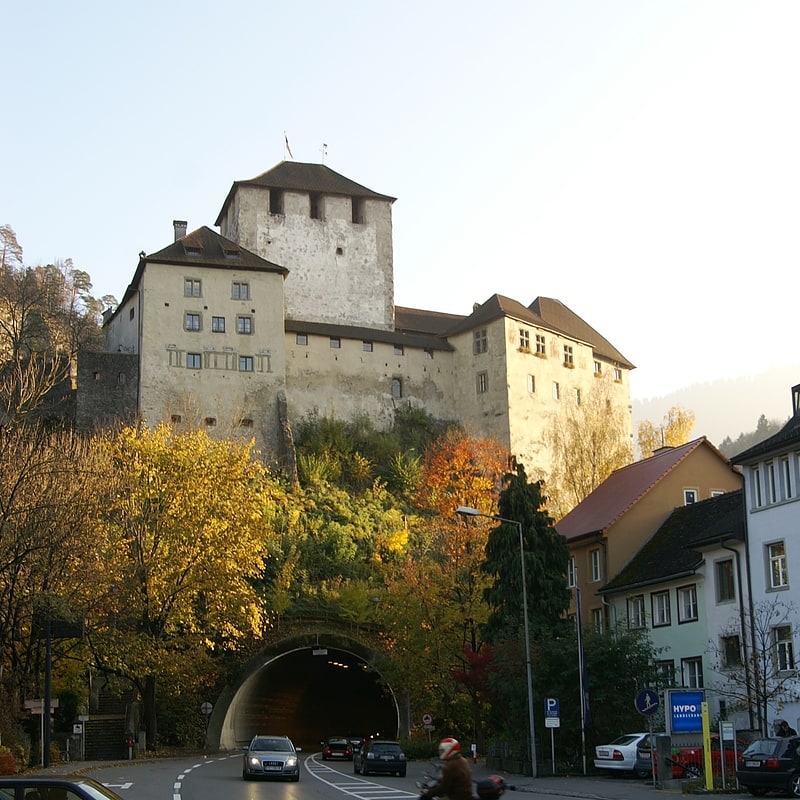
Museum in Feldkirch, Austria. Schattenburg is a castle, museum and restaurant in Feldkirch, Vorarlberg. Schattenburg is 480 metres above sea level..
Its name is assumedly derived from the word stem "schatte, schad" meaning "protection, shield".[41]
Address: Burggasse 1, 6800 Feldkirch
Mariazell Basilica, Mariazell
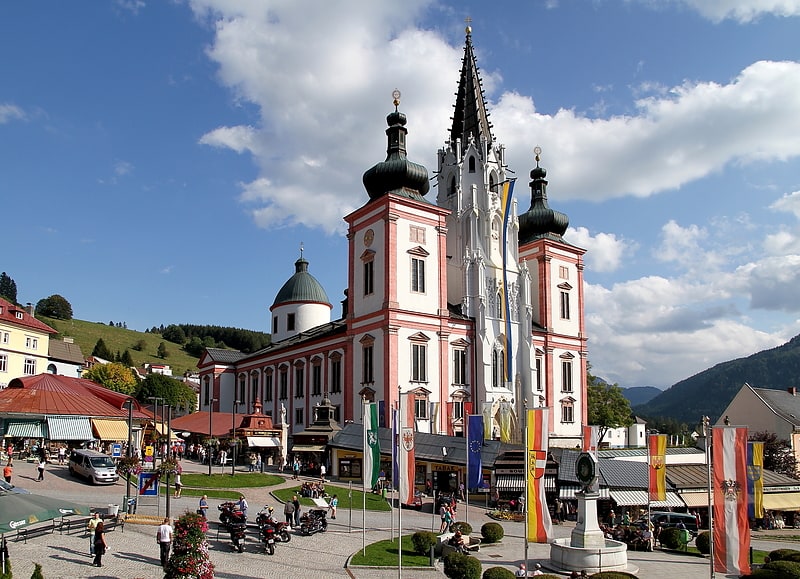
Also known as: Basilika von Mariazell
Church building in Mariazell, Austria. Mariazell Basilica, also known as Basilica Mariä Geburt, is a Roman Catholic church building in Mariazell, Austria. It is the most important pilgrimage destination in Austria and one of the most visited shrines in Europe. In the church, a miraculous wooden image of the Virgin Mary is venerated.
Pope Pius X personally raised the sanctuary to the status of a minor basilica by a Motu proprio in 10 November 1907. Later, he ensured the coronation of the Marian image by a decree on 8 September 1908. Mariazell is the only church named as a national shrine of all German-speaking countries.[42]
Address: Benedictus-Platz 1, 8630 Mariazell
Artstetten Castle, Melk
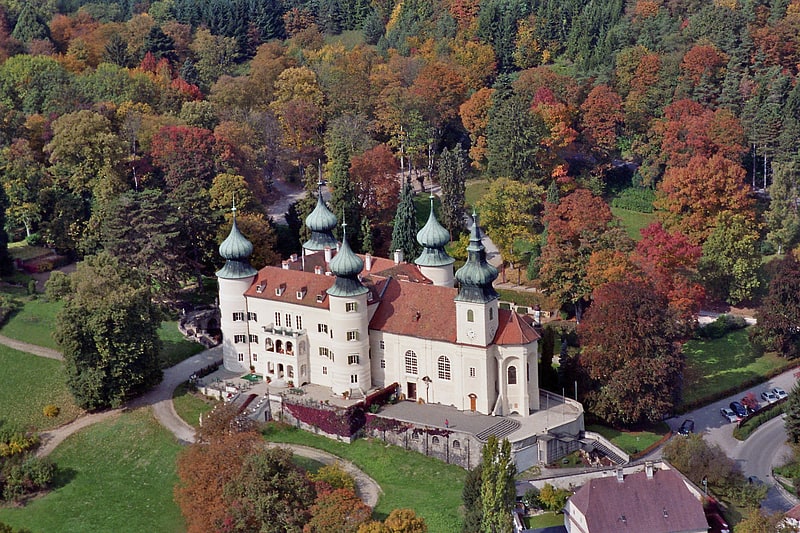
Also known as: Schloss Artstetten
Historical castle with tours and exhibits. Artstetten Castle is a château near the Wachau valley in Lower Austria, in the community of Artstetten-Pöbring.[43]
Address: Schlossplatz 1, 3661 Artstetten
Austrian Jewish Museum, Eisenstadt
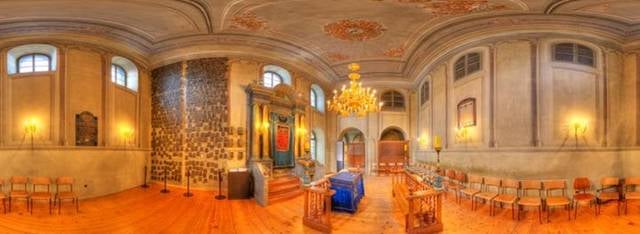
The Austrian Jewish Museum is located on Unterbergstraße 6 in Eisenstadt, Austria. The museum was founded in 1972 by Kurt Schubert, and was the first Jewish museum to open in Austria after 1945.[44]
Address: Unterbergstraße 6, 7000 Eisenstadt
Burgruine Rauhenstein, Baden bei Wien
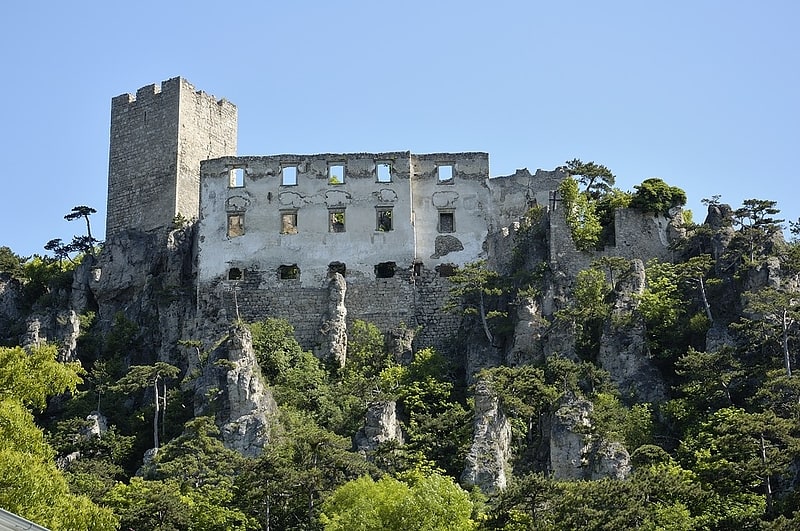
Castle in Baden bei Wien, Austria. Burgruine Rauhenstein is a castle in Baden bei Wien, Lower Austria, Austria. It was constructed in the 12th century. It is known to be the location where Karl van Beethoven, Ludwig van Beethoven's nephew, attempted suicide in July 1826.[45]
Hechtsee, Kufstein

Lake in Austria. Hechtsee is a lake in Tyrol, Austria. It is also the name of a scattered village. Both ar part of the Kufstein District.
The Austria–Germany border is located 20 meters north of the lake.[46]
Address: Hechtsee 8a, 6330 Kufstein
Cathedral of the Assumption of Mary and St. Rupert, Wiener Neustadt

Also known as: Dom von Wiener Neustadt
Catholic church in Wiener Neustadt, Austria. Wiener Neustadt Cathedral, or the Cathedral of the Assumption of Mary and St. Rupert, is a Catholic church located in Wiener Neustadt, Austria. Now a parish church, it was previously the cathedral of the diocese of Wiener Neustadt between 1468 and 1785, the year of the suppression of the diocese.
The location and orientation of the building were selected and designed in the Middle Ages. The nave faces north and west in alignment with sunrise on the day of Pentecost on May 24, 1192, when Duke Leopold V was invested by Emperor Henry VI.
In 1207 the construction of the Romanesque church began. It was consecrated in 1279. From 1588 to 1630, Melchor Klesl was the administrator of the diocese, and built the first Baroque pulpit. The Baroque altar with the altarpiece of the Assumption of Mary by Giandomenico Cignaroli was fitted in 1776. In 1886 the westwork and its towers were demolished because of damage from an earthquake; they were later rebuilt under the direction of the Viennese architect Richard Jordan.
On March 6, 2012, a fire affected the cathedral, which was closed for six months to allow for repairs.[47]
Address: Dompl. 3-11, 2700 Wiener Neustadt